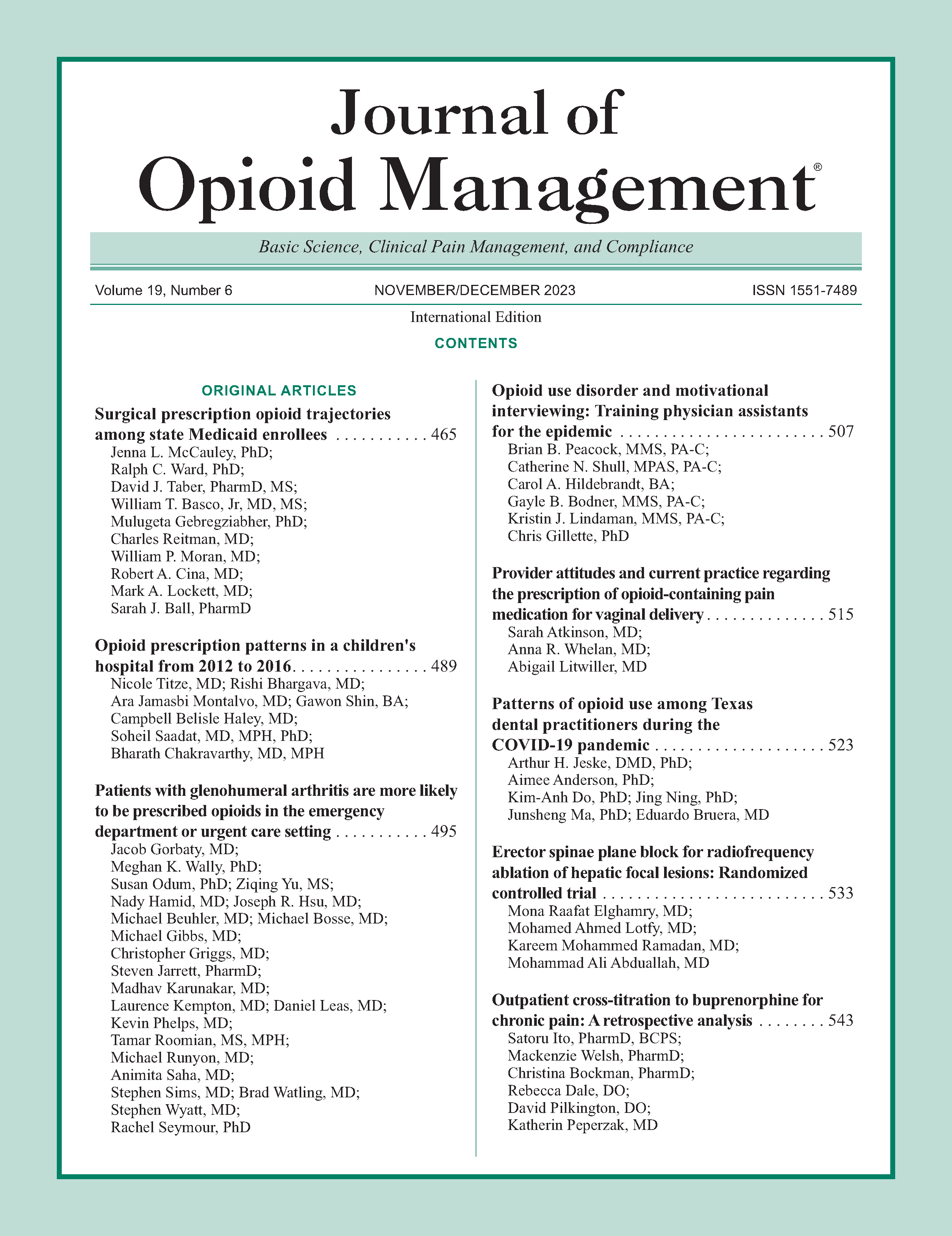Opioid prescription patterns in a children's hospital from 2012 to 2016
DOI:
https://doi.org/10.5055/jom.0833Keywords:
pediatrics, opioids, pain management, pain medicationAbstract
Study objective: Pain management is a widely discussed topic, especially in the setting of the current opioid epidemic. Previous studies have shown that the use of opioids increased in the adult population. We aimed to look at the use of narcotic and non-narcotic pain medications at a large pediatric hospital to discern if patterns of pediatric pain management changed over time.
Methods: 58,402 analgesic prescriptions of patients 0-21 years of age were analyzed from May 2012 to November 2016. A logistic regression model was fitted to examine the association of age, sex, primary diagnosis, and the length of hospital stay with probability of opioid prescription.
Results: 36,560 patients aged 0-21 years (mean: 10.5, median: 11.0, and standard deviation (SD): 7.42) received analgesic pain medications. 21,847 (59.8 percent) patients were prescribed more than one analgesic. There was a male predominance in patients <15 years of age; however, in adolescents >16 years, females constituted 57.1 percent of patients. Data also showed a statistically significant reduction of opioid prescriptions from 2012 to 2016 (p < 0.001). Age and length of hospital stay were directly associated with opioid prescription (p < 0.001).
Conclusion: Data show that there is a decrease in overall opioid prescriptions among pediatric patients, which may be secondary to new Food and Drug Administration regulations and increased awareness of morbidity associated with opioid use. Not surprisingly, increased hospital stay and increase in age lead to more analgesic prescriptions. Further investigation is needed to determine the differences within opioid prescription patterns.
References
de Freitas GRM, de Castro CGJ, Castro SMJ, et al.: Degree of knowledge of health care professionals about pain management and use of opioids in pediatrics. Pain Med. 2014; 15: 807-819. DOI: 10.1111/pme.12332. DOI: https://doi.org/10.1111/pme.12332
Yackey KJ, Rominger AH: Are we adequately treating pain in children who present to US emergency departments?: Factors that contribute to pain treatment in pediatric patients. Pediatr Emerg Care. 2018; 34: 42-46. DOI: 10.1097/PEC.0000000000000750. DOI: https://doi.org/10.1097/PEC.0000000000000750
Goyal MK, Kuppermann N, Cleary SD, et al.: Racial disparities in pain management of children with appendicitis in emergency departments. JAMA Pediatr. 2015; 169: 996. DOI: 10.1001/jamapediatrics.2015.1915. DOI: https://doi.org/10.1001/jamapediatrics.2015.1915
Miech R, Johnston L, O'Malley PM, et al.: Prescription opioids in adolescence and future opioid misuse. Pediatrics. 2015; 136: E1169-E1177. DOI: 10.1542/peds.2015-1364. DOI: https://doi.org/10.1542/peds.2015-1364
Tadros A, Layman SM, Davis SM, et al.: Emergency department visits by pediatric patients for poisoning by prescription opioids. Am J Drug Alcohol Abuse. 2016; 42: 550-555. DOI: 10.1080/00952990.2016.1194851. DOI: https://doi.org/10.1080/00952990.2016.1194851
Harris BR: Talking about screening, brief intervention, and referral to treatment for adolescents: An upstream intervention to address the heroin and prescription opioid epidemic. Prev Med. 2016; 91: 397-399. DOI: https://doi.org/10.1016/j.ypmed.2016.08.022
Groenewald CB, Rabbitts JA, Gebert JT, et al.: Trends in opioid prescriptions among children and adolescents in the United States: A nationally representative study from 1996 to 2012. Pain. 2016; 157: 1021-1027. DOI: 10.1097/j.pain.0000000000000475. DOI: https://doi.org/10.1097/j.pain.0000000000000475
Mazer-Amirshahi M, Mullins PM, Rasooly IR, et al.: Trends in prescription opioid use in pediatric emergency department patients. Pediatric Emerg Care. 2014. DOI: 10.1097/PEC.0000000000000102. DOI: https://doi.org/10.1097/PEC.0000000000000102
Anderson KT, Bartz-Kurycki MA, Ferguson DM, et al.: Too much of a bad thing: Discharge opioid prescriptions in pediatric appendectomy patients. J Pediatr Surg. 2018; 53(12): 2374-2377. DOI: https://doi.org/10.1016/j.jpedsurg.2018.08.034
Harbaugh CM, Lee JS, Hu HM, et al.: Persistent opioid use among pediatric patients after surgery. Pediatrics. 2018; 141(1): e20172439. DOI: https://doi.org/10.1542/peds.2017-2439
Ortega HW, Velden HV, Truong W, et al.: Socioeconomic status and analgesia provision at discharge among children with long-bone fractures requiring emergency care. Pediatr Emerg Care. 2018; 37(9): 456-461. DOI: https://doi.org/10.1097/PEC.0000000000001667
Cimpello LB, Khine H, Avner JR: Practice patterns of pediatric versus general emergency physicians for pain management of fractures in pediatric patients. Pediatr Emerg Care. 2004; 20(4): 228-232. DOI: https://doi.org/10.1097/01.pec.0000121242.99242.e0
Cacciotti C, Vaiselbuh S, Romanos-Sirakis E: Pain management for sickle cell disease in the pediatric emergency department: Medications and hospitalization trends. Clin Pediatr (Phila). 2017; 56(12): 1109-1114. DOI: https://doi.org/10.1177/0009922816674521
Published
How to Cite
Issue
Section
License
Copyright 2005-2025, Weston Medical Publishing, LLC and Journal of Opioid Management. All Rights Reserved.











